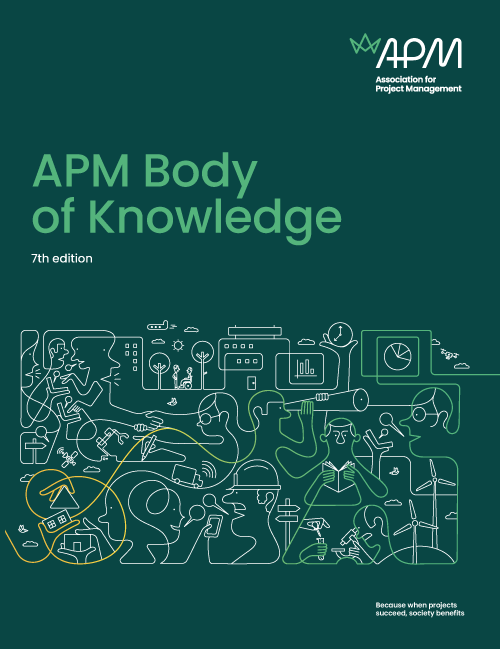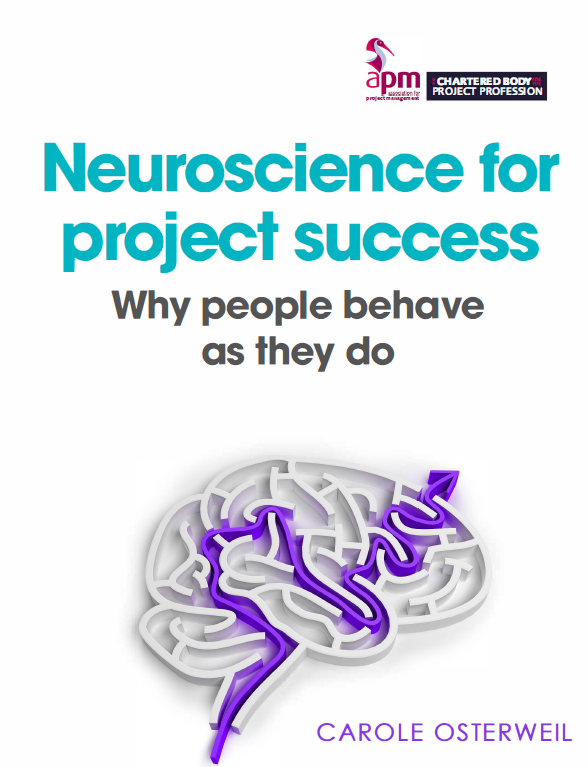

Neuroscience for project success: Why people behave as they do
APM members can claim 10% discount on paperback publications by using code APMMEM10 at checkout. Plus, FREE member digital copy downloads on named titles. Not a member yet? Join us
- Paperback
-
Special offer
-
Was £25.00Now £15.00 - Digital Copy
- £20.00
About this book
Description
Imagine understanding how the brain works. What if you knew what drives emotions, behaviours and decision making – in you and others? If all actions were informed by knowing why people behave as they do, how would it impact project success?
Carole brings the magic of brain science into the reality of teamwork and projects using examples from real project professionals and explanations from some of the foremost brain, behavioural and social scientists.
This book takes the project professional into the science and practice of brain science on projects. It also creates a framework of practices and behaviours that will help any project team perform to a higher level and experience greater wellbeing.
Details
Paperback: 246x189mm, 160pp, 2022
Author: Carole Osterweil
Publisher: APM
ISBN: 978-1-913305-17-8
Reviews
Neurodivergent or Neurotypical, Neuroscience Levels Opportunity and Optimises Outcomes
As a neurodivergent, transformational leader, I came to Carole Osterweil’s book Neuroscience for Project Success with a question: ‘Will this content help me engage with neurodivergent stakeholders and/or realise success as a project change manager?’
I found this book enormously helpful.
Firstly, it highlights a universal truth. All project and change professionals operate in a stressful, VUCA (Volatile, Uncertain, Complex & Ambiguous) world, and everyone – whether they identify as neurodivergent or not – faces the same central challenge. Under constant stress, our Thinking brains are frequently ‘taken offline’. This results in sub-optimal behaviors and decisions which make it far harder to realize project benefits.
Secondly, it lays out a set of universal design principles to follow whether you identify as neurodivergent or neurotypical. Grounded in neuroscience, these principles and associated tools make our VUCA world less VUCA, bringing project success within reach. Essentially, they center on learning to ‘bring our Thinking brains online’. This powerful act creates the conditions for people to accept and engage with change, and it safeguards cognitive capacity and mental health.
Neuroscience for Project Success has a reader-friendly structure and style combined with person-centric examples and organisational case studies. I found it an accessible and easy read.
Full of practical lessons, I returned to several sections more than once as I applied the principles and tools to my role as a Transformation Lead. These have helped me:
- understand why I behave the way I do,
- evolve my professional identity,
- prioritize my wellbeing at work, and
- lead my projects and programmes with confident humility and curiosity about behaviours.
Together they have revolutionized my relationships with Project Boards and Business Executives/Sponsors.
I highly recommend Neuroscience for Project Success to everyone working on projects, change and transformation.
Carrick Brown
Just finished reading Carole Osterweil unique book about neuroscience in #projectmanagment and delivery. Here is a summary of what I learned:
Construction has lost many experienced people since 2008 so youngsters no longer benefit from the natural mentorship that comes from working with others.
Add to that complexity - a single program may have 40 to 50 novel and technically challenging projects, and there are gaps. Gaps in terms of knowledge, and just as important, the calming voice of experience.
People often focus on technical challenges, forgetting that delivering a construction project depends on the people. In the post Covid world, with its political and economic uncertainty, the environment is more demanding than ever, and like it or not people are fragile.
This book is one of kind, providing a practical toolkit that ensures a sense of clarity informs your actions and decision making in this stressful project management context.
8 Reasons to read this book:
- It provides a toolkit for delivering construction projects in this VUCA, (volatile, uncertain, complex, and ambiguous), world.
- It’s easy to read and there’s no psychobabble! It gives a sense of clarity to your actions and decision-making.
- It provides enough knowledge about neuroscience to make it very easy to understand ‘why people behave as they do’, and practical methods for deploying this knowledge in a project management context.
- There’s a pragmatic focus on building your emotional intelligence and improving the quality of your decision-making.
- Its novel tools, such as the Project Stress Cycle, help illustrate and address the people challenges of program delivery.
- It offers a route for building psychological safety, increasing collaboration, and moving away from the toxic culture that characterized construction in the past.
- It includes mini and extended case studies that show how the tools have been used by individuals and organizations in real life.
Stephen Slessor, Managing Director - Galliford Try Environment | Delivering Design & Build, Asset Optimisation, & Capital Maintenance Services to the UK Water Sector
You must agree that projects, which by definition produce a unique outcome, are bound to deal with risk and uncertainty. Also, my definition of project leadership, getting work done through others, means that as a project leader, you must understand and influence people.
Put those two together and you have a very good reason why this book is so fundamentally important if you want to be a project leader, especially in today’s world, in which the planning and scheduling aspects of project management can be so easily automated. What cannot be automated is the ability to deal with those “others” who are accomplishing your project’s success. Carole Osterweil has made the neuroscience of projects accessible to you. This is exceedingly and increasingly valuable. Think of the times when these aspects of your project arise:
- A decision must be taken under stress and time constraints
- An intense negotiation within or outside the team must go well
- You must engage with stakeholders
- It’s important to build cohesion in your team despite conflict
- A safe environment must be established in which it’s fair to raise issues
From my decades of experience in hundreds of real projects, these things happen. A lot. In fact, in my role at Boston University’s graduate Project Management program, I am often asked to help students find jobs or to advance their careers. This means I am in tune with what employers are seeking. Most, if not all of the elements from list above, well-covered by Osterweil’s book, show up frequently in job advertisements for the best project jobs. Not coincidentally, these attributes are increasingly part of the new definition of projects as a ‘system for value delivery’. They are also descriptive of the servant leadership behavior that is now a major thread in the APM Body of Knowledge, 7th edition and in APM standards. Employers and standards-setters know how important this is. This book will aid you in your job, your career, and your career advancement, while also helping to attain project success.
Rich Maltzman, PMP, Master Lecturer, Boston University
“With this book, Carole brings the magic of brain science into the reality of teamwork and projects using examples from real project professionals and explanations from some of the foremost brain, behavioural and social scientists…”
Ruth Pearce, The Project Manager Burnout Coach, Member of the Advisory Board of the Institute for Neuro & Behavioral Project Management and author of Be a Project Motivator
“What makes the difference between success and failure is always ‘the people stuff’. Most of us don’t understand why people behave as they do as individuals and, crucially, as teams. We know that stressful environments and experiences lead to poor delivery and poor mental health... Carole provides actionable advice, skills, tools and case studies for practical, mindful results.”
Keith Leslie, Chair of Samaritans in UK & Ireland and author of A Question Of Leadership
“Fact:
1) Managing change is complex.
2) The human brain is the most complex entity in the known universe.
Unfortunately, few project and programme managers seem to connect the two facts - and then wonder why their change projects fail.
This book explains how to practically manage the complexities of human behaviour in a project environment. Read it and deliver!”
Stephen Carver, Speaker in Change and Crisis Management at Cranfield University School of Management
"I think it is time to confess that what I once referred to as psycho-babble may be the keys to the Kingdom when it comes to understanding why people behave the way they do. This could change EVERYTHING... If I can be convinced, I know you can."
Lee Lambert
Author bio
Carole Osterweil is a project troubleshooter and coach who’s on a mission to bring an understanding of how the human brain works to the world of project management and business transformation.
Carole’s pioneering approach is informed by over 20 years as an educator and consultant at Ashridge – Hult business school; her experience as an international project leader endeavouring to Walk in Fog, and her training in psychotherapy and the arts. Now based at Visible Dynamics, she also coaches on the UK Government’s Project Leadership Programme at Cranfield University.
Books you may like

